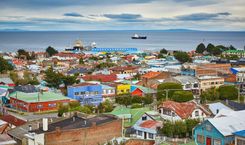What are the best beaches to visit in Chile?
A typical Chile itinerary might focus on Patagonia, the Atacama Desert or the Lake District. But the coastline – often skipped – offers just as much adventure. Stretching over 6,000km, Chile’s Pacific edge delivers everything from surf towns to silent, cliff-backed coves.
This isn’t a place for tropical lounging. The water’s cold, the winds can be fierce, and the best spots often take effort to reach. But that’s part of the appeal. Some beaches sit just off the highway, easy to tag onto a road trip. Others require a boat ride or a hike through dense forest. What links them is a sense of space – and a lack of crowds.
If you’re wondering what are the best beaches in Chile, this list brings together the ones that stand out – not just for their setting, but for the experience they offer.
1. Pan de Azúcar National Park
Tucked between the Antofagasta region and the edge of the Atacama Desert, Pan de Azúcar National Park is one of Chile’s most quietly spectacular coastal escapes. Its long, empty beaches stretch across over 100,000 acres – all white sand, rust-red cliffs and near-total silence.
There are four basic campsites scattered across the coast, where you can fall asleep under one of the clearest night skies on Earth. This isn’t just about the beach, though. The surrounding desert and hills are full of life – guanacos, desert foxes, otters and pelicans all roam the park. Down at the coast, the fishing village of Caleta Pan de Azúcar runs boat trips out to the nearby island, where you’ll find a colony of Humboldt penguins clinging to the rocks.
How to get to Pan de Azúcar
The park lies roughly halfway between Antofagasta and Copiapó. The nearest town is Chañaral, 17km to the south – from there, you’ll need a car or tour to reach the coast. Public transport doesn’t reach into the park.
When to visit Pan de Azúcar
Go between September and April for clear skies and warmer weather. Summers are hot but dry. Outside these months, it can be cool and foggy – beautiful, but less ideal for camping.





















